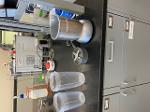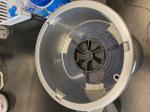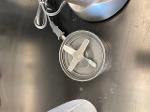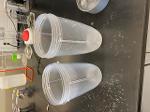Household Equipment in a Laboratory May Not Be the Best Choice
What Happened?
On August 18, 2020, a student was performing a homogenization procedure with a Nutribullet™ blender when the blender separated and the student fingers were cut by the blade. The procedure being performed involved flash freezing ½ inch square pieces of raw meat with liquid nitrogen. The frozen meat was then placed in the Nutribullet™ cup and blended into a powder. However, during the procedure the Nutribullet™ separated due to over pressurization from the liquid nitrogen sublimation (transition of a substance directly from the solid to the gas state, without passing through the liquid state). During the separation, the student's fingers were cut by the blade. The written procedure called for the frozen pieces to stay in the Nutribullet™ cup unattached until the vapor from the liquid nitrogen had dissipated; however, during this incident this step was skipped and sufficient liquid nitrogen remained to create over pressurization.
The student rinsed the wounds until the bleeding had stopped and then the wounds were cleaned, bandaged, and iced. After consultation with the departmental safety officer, the student sought medical treatment because raw meat was being handled and there was concern about bacterial contamination in the laceration wounds.
What was the cause?
Equipment was being used outside of manufacturer's criteria. The Nutribullet™ is not designed for laboratory use and does not have appropriate safety features, such as a pressure relief device, nor is it manufactured for use with cryogens like liquid nitrogen. Additionally, the step in the SOP instructing the worker to allow the liquid nitrogen to completely stop sublimation was skipped.
What corrective actions were taken?
This incident has been brought to the Institutional Laboratory Safety Committee (ILSC) for review. The issue of the use of non-laboratory grade equipment in research and
teaching work areas is being discussed.
How can we prevent incidents like this?
- Use equipment that is designed for laboratory use.
- Use equipment that has appropriate safety features to mitigate the hazards of the procedure to prevent equipment failure (e.g., pressure relief, electrical grounding, etc.)
- Ensure procedures are clearly written and that worker proficiencies of procedures are evaluated regularly.
Environmental Health & Safety
-
Address
Texas Tech University, 407 Flint Ave, Lubbock, TX 79409 (Mail Stop 1090) -
Phone
806.742.3876 -
Email
safety@ttu.edu




